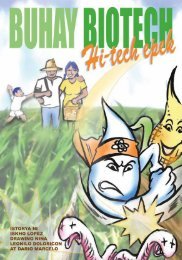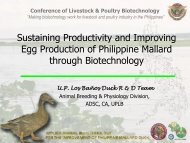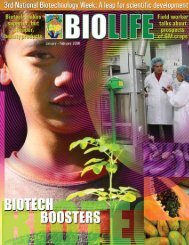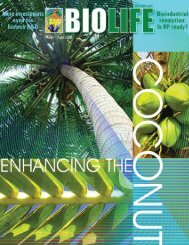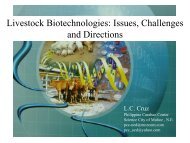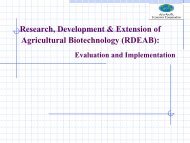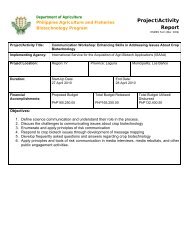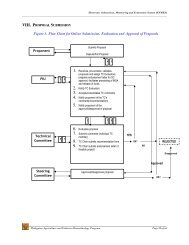Download PDF - SEARCA Biotechnology Information Center
Download PDF - SEARCA Biotechnology Information Center
Download PDF - SEARCA Biotechnology Information Center
You also want an ePaper? Increase the reach of your titles
YUMPU automatically turns print PDFs into web optimized ePapers that Google loves.
January – March 2005 BIO LIFE<br />
17<br />
Table 1. Expenditures on Insecticide Use,<br />
407 Bt and non-Bt Corn Farmers, Philippines, 2003-2004<br />
Insecticide Cost (PhP/ha)<br />
Location/Cropping<br />
No. of<br />
observations Bt Non-Bt Difference<br />
1st Cropping<br />
Camarines Sur 53 149 328 179.00<br />
Bukidnon 68 134 56 (78.00)<br />
2nd Cropping<br />
Bukidnon 51 0 47 47.00<br />
South Cotabato 103 206 652 446.00<br />
Isabela 132 149 281 132.00<br />
ALL 407 156 324 168.00<br />
Source of data: ISAAA Corn Survey, 2003-2004<br />
Table 2. Yield differences between Bt and non-Bt corn farms,<br />
407 farmers, Philippines, 2003-2004<br />
CROPPING/LOCATION Bt Non-Bt % Difference<br />
1st cropping<br />
Camarines Sur 4516.67 3287.46 37.39 **<br />
Bukidnon 4215.90 3324.18 26.83 ns<br />
All locations 4301.83 3307.75 30.05 **<br />
2nd cropping<br />
Bukidnon 2868.36 3566.30 (19.57) ns<br />
Isabela 5303.85 4483.77 18.29 ***<br />
South Cotabato 4793.55 3486.31 37.50 ***<br />
All locations 4890.28 3789.96 29.03 ***<br />
Both croppings 4849.50 3610.31 34.32 ***<br />
*** = significant at 1 percent<br />
** = significant at 5 percent<br />
ns = not significant<br />
Source of data: ISAAA Corn Survey, 2003-2004<br />
Lesser use of insecticide<br />
Before the adoption of Bt corn in the Philippines,<br />
damage by the Asian corn borer on<br />
corn yield had reached as high as 30 percent,<br />
or a low of 4.3 percent. Farmers used insecticides,<br />
which have been proven costly and<br />
unsafe to the human health and to the environment.<br />
With the Bt corn, Yorobe said insecticide<br />
use by farmers was reduced based on<br />
the amount spent on insecticides per hectare.<br />
About P168 per hectare was saved on<br />
insecticide expenditures by Bt corn farmers.<br />
“This implies that farmers sprayed fewer times<br />
and used less insecticides,” he said.<br />
Yorobe explained that Table 1 (Table 4<br />
in the study) showed that the amount used<br />
by non-Bt farmers on insecticides was relatively<br />
high in Isabela and Camarines Sur<br />
because of the prevalent incidence of corn<br />
borer. The cost advantage was not conspicuous<br />
in Bukidnon especially during the<br />
second (dry) season because the incidence<br />
of corn borer was slight. More insecticide<br />
use was also reported in Bukidnon in the<br />
wet season because of the prevalence of<br />
corn borer.<br />
High yield and income<br />
Of course, the major consideration in the<br />
use of new technology—this time Bt corn—<br />
is profitability. Farmers venture into new<br />
methods to be able to increase their income.<br />
The reduction in pest damage, Yorobe said,<br />
translates to better yield and income. He<br />
stressed: “Experiences in other countries<br />
already indicate the superior financial performance<br />
of Bt-corn farms over the non-Bt<br />
corn ones.” A comparison of mean yield per<br />
hectare of Bt corn and non-Bt corn showed<br />
the “substantial absolute advantage” of Bt<br />
corn (Table 2)<br />
(Table 2 in the study). Yorobe observed<br />
that in all locations in both cropping seasons,<br />
the Bt corn farms had a yield advantage<br />
of 34.32 percent over non-Bt corn users,<br />
with a high of more than 37 percent in<br />
Camarines Sur and South Cotabato. The<br />
average yield of Bt corn farms was 4,850kg/<br />
hectare compared to only 3,610kg/hectare<br />
for non-Bt corn.<br />
The study said that financial evaluation<br />
on the performance of Bt corn farms also<br />
indicated an increase of about 25 percent in<br />
profitability over non-Bt corn farms. The yield<br />
differences between Bt corn and non-Bt corn<br />
farms were “statistically significant” in all locations,<br />
except in Bukidnon, the study said,<br />
at 1-percent level for the first cropping, and<br />
5 percent level for the second cropping. The<br />
favorable growing conditions in Isabela and<br />
South Cotabato in the second or dry season<br />
contributed significantly to better corn production,<br />
Yorobe said.<br />
Table 3 (Table 5 in the study) presented<br />
an evaluation of the financial performance<br />
of Bt and non-Bt farms for 2003-2004. The<br />
production cost of a kilo of Bt corn was lower




